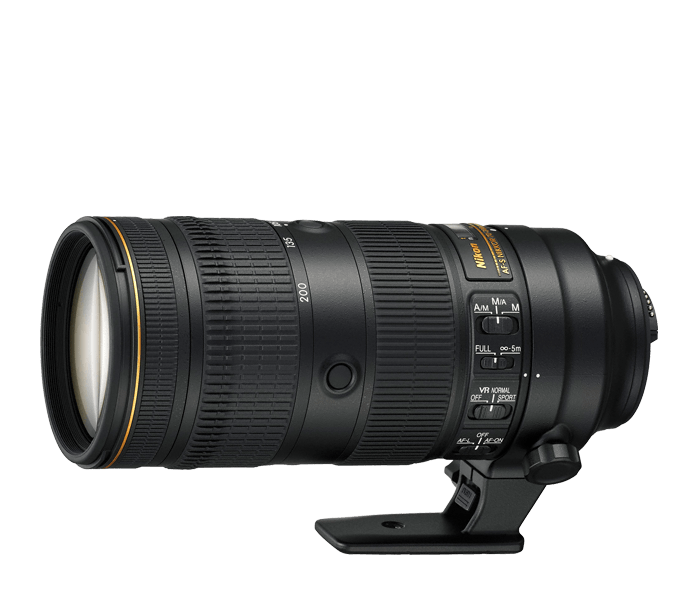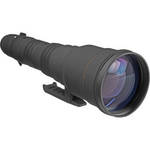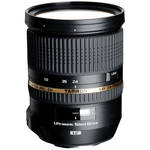Submitted by David Cardinal on Wed, 10/19/2016 - 09:38
 The Nikon 70-200mm f/2.8 lens (in all its incarnations) may be one of the most popular pro lenses ever. Now, Nikon has improved on an already great lens with the new . It features a closer MFD (Minimum Focusing Distance), new coatings for yet lower distortion, improved VR, all at about the same size and weight (actually a touch lighter according to the specs). The only downside is the by now familiar price increase. The current is selling for about $2100, while the .
The Nikon 70-200mm f/2.8 lens (in all its incarnations) may be one of the most popular pro lenses ever. Now, Nikon has improved on an already great lens with the new . It features a closer MFD (Minimum Focusing Distance), new coatings for yet lower distortion, improved VR, all at about the same size and weight (actually a touch lighter according to the specs). The only downside is the by now familiar price increase. The current is selling for about $2100, while the .
Submitted by David Cardinal on Wed, 08/17/2016 - 08:33
 If you’ve been considering giving up on DSLRs and shifting to a smaller, possibly-lower-cost mirrorless camera, Nikon wants to make you think again. The new builds on the image quality of Nikon’s DSLRs and adds some intriguing usability features – like SnapBridge which should make image sharing with your mobile device much easier. At 5 fps, it should have enough performance for most. And you can get it in a kit with Nikon’s new 18-55mm VR lens for $650 when it ships in September.
If you’ve been considering giving up on DSLRs and shifting to a smaller, possibly-lower-cost mirrorless camera, Nikon wants to make you think again. The new builds on the image quality of Nikon’s DSLRs and adds some intriguing usability features – like SnapBridge which should make image sharing with your mobile device much easier. At 5 fps, it should have enough performance for most. And you can get it in a kit with Nikon’s new 18-55mm VR lens for $650 when it ships in September.
Submitted by David Cardinal on Fri, 10/16/2015 - 08:07
Sigma continues to roll out very-high-quality, professional-grade, lenses in its Art family. These lenses are super-fast, super-sharp, and reasonably priced for their features and image quality. The new, full-frame-ready, is available for . It uses both “F-type” low dispersion glass and other low-dispersion glass technologies in its 15-element construction. Advanced lens coatings are also used. It has a hypersonic focus motor, and a minimum focusing distance of 10.9”. Like other lenses in the family, it can be tweaked using Sigma’s USB dock and software. A 9-bladed aperture helps ensure a smooth-looking bokeh. It will be available in Canon EF, Nikon F, and Sigma SA mounts.
Submitted by David Cardinal on Wed, 05/20/2015 - 16:01
 Wildlife photographers have some amazing, and amazingly expensive, lens options from Canon and Nikon, but for many the huge price tags – not to mention large size and weight -- make them impractical. Instead, they have needed to compromise image quality to meet their budget. Fortunately, modern manufacturing techniques and lens design software improvements have continued to improve the quality of third-party value-priced lenses. The first of this new breed is the that I field tested in Texas during my workshops this month...
Wildlife photographers have some amazing, and amazingly expensive, lens options from Canon and Nikon, but for many the huge price tags – not to mention large size and weight -- make them impractical. Instead, they have needed to compromise image quality to meet their budget. Fortunately, modern manufacturing techniques and lens design software improvements have continued to improve the quality of third-party value-priced lenses. The first of this new breed is the that I field tested in Texas during my workshops this month...
Submitted by David Cardinal on Wed, 03/04/2015 - 11:04
One by one Sony and other mirrorless camera manufacturers have broken down the barriers to dumping a heavy DSLR and going lighter. Faster Autofocus and amazingly-good Electronic Viewfinders have been key in this effort. Just about the only remaining stumbling block for those used to the large array of lens options provided by Nikon and Canon is the limited selection of lenses for mirrorless models. Sony has quite a variety of lenses, but they come in several different mounts, and many of the best require an adapter for use on their newest mirrorless models like the excellent new . Sony is working hard to address the issue, and today introduced four new lenses for its full-frame mirrorless models:
Submitted by David Cardinal on Tue, 11/11/2014 - 08:05
Canon shooters who don’t want to lug a huge and expensive telephoto zoom along with them, and haven’t wanted to go third party have had only one option for the past 16 years (believe it or not, that’s how long it has been). Finally Canon has introduced a totally revamped model, the . The new lens has all the right specs:
Submitted by David Cardinal on Wed, 08/13/2014 - 09:53
Every July I return to Alaska to photograph the amazing Coastal Brown (aka “Grizzly”) Bears. Over the course of 15 years I’ve used over a dozen different cameras, and at least that many lenses to capture images. Typically at least one of my lenses would be a massive telephoto (400mm f/2.8 or 200-400 f/4, or 120-300 f/2.8). This year, as part of my ongoing effort to identify lighter, less expensive alternatives to large and extremely expensive lenses, I decided to shoot for the entire two safaris with “just” a attached to my Nikon D610. My hope was to see whether this new, sub-$3K lens could do a good job of subbing for larger, more expensive alteratives….
Submitted by David Cardinal on Tue, 07/08/2014 - 13:08
I’m often asked what lenses I recommend for various photo subjects – typically right before a reader or client is about to head off on a trip. What often goes without saying is what lenses I don’t travel with. In many cases, these were my “go-to” lenses for many years, but a combination of industry trends has helped me lighten up my traveling kit substantially. The changes aren’t for everyone, but they are worth considering for anyone who has begun to dread traveling with all their gear. Before I plunge in, please remember that I’m not saying these lenses aren’t still some of my favorites, or that you shouldn’t rely on them anywhere and everywhere, just that it is always worth thinking about what you are traveling with and why…
Submitted by David Cardinal on Sun, 04/27/2014 - 15:45
by David Cardinal
 There is no question that Sigma has really upped its game with its new family of Global Vision lenses. I love the GV-version of the , and continue to feel it is the world’s . This month I’ve had the pleasure of shooting with its new on both a and a . The short version is that the lens lives up to the Global Vision brand, but read on to see whether it might be the right mid-range zoom for you:
There is no question that Sigma has really upped its game with its new family of Global Vision lenses. I love the GV-version of the , and continue to feel it is the world’s . This month I’ve had the pleasure of shooting with its new on both a and a . The short version is that the lens lives up to the Global Vision brand, but read on to see whether it might be the right mid-range zoom for you:
Unless you make a lot of money with your mid-range zoom lens, or are willing to spend what it takes to get the best, $1900 for the 2 pound is a hard price to justify. For that price, you get an ultra-sharp, ultra-fast, lens, but you don’t even get VR. I’ve enjoyed using Sigma’s version, the . It is much less expensive, but not as solidly built and also isn’t stabilized. Until now there hasn’t been a value-priced version of a 24-70 f/2.8 that could measure up to the Nikon. That’s why I was excited to work with the new , which not only featured a fast focus motor but unique among mid-range pro zooms, also has image stabilization….
 Mid-range zooms have become the bread and butter lens for almost all photographers, pro and amateur. So each new announcement in that space is greeted with tremendous energy and excitement. Nikon’s overhaul of the venerable 28-70mm f/2.8 into the digital full frame friendly 24-70mm f/2.8 was big news for Nikon shooters. But the 24-70 is large, heavy, expensive and doesn’t have VR (Vibration Reduction). Sigma’s 24-70 helps with the first three but it also doesn’t have VR. And neither offers the kind of large range photographers have come to want from their zooms. So enter the new Nikon 24-120mm f/4 AF-S VR Lens—Nikon’s third offering in that zoom range. Read on to find out if it finally the perfect fit for your needs…
Mid-range zooms have become the bread and butter lens for almost all photographers, pro and amateur. So each new announcement in that space is greeted with tremendous energy and excitement. Nikon’s overhaul of the venerable 28-70mm f/2.8 into the digital full frame friendly 24-70mm f/2.8 was big news for Nikon shooters. But the 24-70 is large, heavy, expensive and doesn’t have VR (Vibration Reduction). Sigma’s 24-70 helps with the first three but it also doesn’t have VR. And neither offers the kind of large range photographers have come to want from their zooms. So enter the new Nikon 24-120mm f/4 AF-S VR Lens—Nikon’s third offering in that zoom range. Read on to find out if it finally the perfect fit for your needs…
Submitted by David Cardinal on Wed, 10/27/2010 - 11:41
Read on for rebates on Canon & Nikon lenses, Lens and camera combos, the surprisingly good Tamron 18-270, high speed CompactFlash cards and a state of the art Canon HD Camcorder.
Submitted by David Cardinal on Wed, 10/06/2010 - 22:36
Submitted by David Cardinal on Thu, 08/19/2010 - 05:41
New NIKKOR Glass Yields an Unprecedented Seven Lenses Released to Date in 2010
MELVILLE, N.Y. Aug. 19 /PRNewswire/ -- Today, Nikon Inc. announced four new lenses to the legendary NIKKOR line to meet the needs of all types of photographers, from those looking for the ideal lens for capturing memories of the school play to pro glass that captures client work in the studio. The new AF-S DX 55-300mm f/4.5-5.6G ED VR, AF-S 28-300mm f/3.5-5.6G ED VR, AF-S 24-120mm f/4G ED VR and AF-S 85mm f/1.4G deliver the optical excellence and stunning image quality that consumers have become accustomed to with AF-S NIKKOR lenses. Nikon's optical engineering experience and devotion to extraordinary standards of excellence have contributed to the strength and legend of the NIKKOR brand. With the addition of these four lenses, 2010 has seen the introduction of a total of seven new NIKKOR lenses, reinforcing Nikon's role as the world leader in optics.
Submitted by David Cardinal on Tue, 02/09/2010 - 08:50
One missing link in Nikon's Pro lens line has been the lack of VR on the mid-range and wide-angle zoom lenses. Certainly VR is not as important on these lenses as on longer focal lengths, but there are many conditions where hand-holding is the only option and a low shutter speed is the best option. Now with the new 16-35mm f/4 AF-S VR Nikon has addressed the shortcoming...The lens features include:
Pages

 The Nikon 70-200mm f/2.8 lens (in all its incarnations) may be one of the most popular pro lenses ever. Now, Nikon has improved on an already great lens with the new
The Nikon 70-200mm f/2.8 lens (in all its incarnations) may be one of the most popular pro lenses ever. Now, Nikon has improved on an already great lens with the new  If you’ve been considering giving up on DSLRs and shifting to a smaller, possibly-lower-cost mirrorless camera, Nikon wants to make you think again. The new
If you’ve been considering giving up on DSLRs and shifting to a smaller, possibly-lower-cost mirrorless camera, Nikon wants to make you think again. The new 
 Wildlife photographers have some amazing, and amazingly expensive, lens options from Canon and Nikon, but for many the huge price tags – not to mention large size and weight -- make them impractical. Instead, they have needed to compromise image quality to meet their budget. Fortunately, modern manufacturing techniques and lens design software improvements have continued to improve the quality of third-party value-priced lenses. The first of this new breed is the
Wildlife photographers have some amazing, and amazingly expensive, lens options from Canon and Nikon, but for many the huge price tags – not to mention large size and weight -- make them impractical. Instead, they have needed to compromise image quality to meet their budget. Fortunately, modern manufacturing techniques and lens design software improvements have continued to improve the quality of third-party value-priced lenses. The first of this new breed is the ![1126138[1] 1126138[1]](http://www.cardinalphoto.com/files/David%20Cardinal/11261381_thumb.jpg)



 There is no question that Sigma has really upped its game with its new family of Global Vision lenses. I love the GV-version of the
There is no question that Sigma has really upped its game with its new family of Global Vision lenses. I love the GV-version of the 

